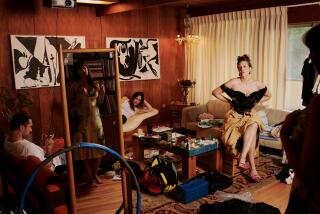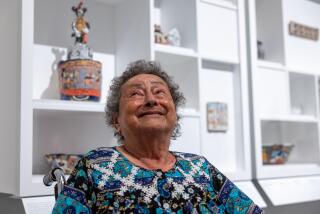Review: ‘Elsa Schiaparelli’: Fashion designer too elusive for words
Among the many remarkable aspects of designer Elsa Schiaparelli’s remarkable life — she became a world-famous couturier without knowing how to sew, collaborated on sartorial projects with Surrealists like Salvador Dali and Jean Cocteau, raised her daughter alone at a time when this was far from the norm — the most remarkable may be that, except to fashion insiders, she is largely unknown.
Schiaparelli was born in Rome in 1890 into a conservative, intellectual, well-to-do Italian family. She shot to fame with a collection of sweaters in 1927 and remained ascendant until the Second World War, occupying a position as the Thomas Edison of the fashion world. She originated numerous ideas that were astonishingly novel at the time: Schiaparelli was the first to design a backless swimsuit with its own built-bra, pair drafty evening gowns with matching formal jackets and straddle the dressy-casual divide with knitwear and mix-and-match separates. She introduced split skirts, or “bloomers,” as day wear, scandalizing the press. And she popularized the big-shouldered silhouette that became the look of 1930s Hollywood. (Her scores of famous clients included Marlene Dietrich, Greta Garbo, Katharine Hepburn, Claudette Colbert and Vivien Leigh.)
Yet she is mainly thought of today as the designer who introduced an electric shade of fuchsia, a color she called “shocking” pink and a signature scent by the same name that came in a zaftig little bottle.
Unfortunately, Meryle Secrest’s new biography, “Elsa Schiaparelli,” is not likely to restore the designer to the forefront of the cultural imagination. Secrest, who has written about Dali, Frank Lloyd Wright, Leonard Bernstein and Stephen Sondheim, doesn’t have a feel for fashion, and her prose lacks authority and insight. In all fairness, she chose a dauntingly hermetic subject: If Schiaparelli kept a diary, it no longer exists, and she wasn’t one for epistolary friendships, “confining herself,” Secrest writes, “as all captains of industry must do, to a few taut commands scrawled across a page.” Her short autobiography, “Shocking Life” — one of Secrest’s main sources, along with Palmer White’s 1986 biography — is an elliptical, cheeky, self-mythologizing affair in which the designer frequently refers to herself in the third person, as “Schiap” (that’s pronounced “Skap”).
More reliable narrators were not to be found. The designer’s contemporaries have passed away, and the pre-1940 journals of diarist Bettina Bergery (née Shaw Jones) whom Secrest calls Schiaparelli’s Boswell, are at large. Schiaparelli’s granddaughter, model, actress and memoirist Marisa Berenson, who has commented on her grandmother’s exceedingly private nature in the press, refused to talk to Secrest. (One hopes this is because she’s penning a remembrance of her own.)
Secrest thus relies on an odd combination of dry factual recitation and bizarre narrative padding. She spills an inordinate amount of ink on the con-artist spiritualist career of Schiaparelli’s ne’er-do-well husband, a theosophist named Wilhelm de Wendt de Kerlor, who left her when their daughter was born. And she makes broad generalizations about the designer’s Italian-ness. We also hear a great deal about her impeccable outfits (“She was wearing a navy-blue travelling suit with a wine-colored insert at the waistline”) and her peripatetic lifestyle. (During World War II the ease with which Schiaparelli traveled led to enduring suspicions that she was a Vichy sympathizer.) Yet we are told almost nothing about her thoughts, motivations, feelings or creative process.
The book, as a result, has a vague, detached, strangely exteriorized quality. Reading it is the literary equivalent of watching television with the sound turned down.
This might seem a fitting biographical approach to a fashion designer, whose job, after all, is to adorn the exterior, but Schiaparelli is a singular case. Her most celebrated creations, Secrest writes, transfigured the underlying ideas of the Surrealist movement, with “its emphasis on the unconscious, the irrational, and the daring,” into fanciful, astonishingly original pieces. These walked the line between fashion and art, but they also managed to be flattering and wearable. With Dali, Schiaparelli created hats in the shape of a pork chop, a high-heeled shoe and an inkwell. Together, they also conceived of a navy blue velour suit with descending bureau-drawer pockets (inspired by Dali’s plaster cast of the Venus de Milo) and a white organza dress printed with a bright-red lobster and green parsley sprigs that Wallis Simpson included in her trousseau for her wedding to the Duke of Windsor.
Even when they weren’t a direct collaboration, her clothes embodied the dreamlike spirit of the Surrealist movement and its impulse to surprise, to shock. She was always exploring “the lacy fringes of consciousness,” as art critic Peter Schjeldahl has written. But from where or what did this mystical bent arise? What were her methods of inspiration, ideation, creation?
The most illuminating parts of this muddled book are those in which Secrest quotes Schiaparelli’s autobiography directly. Here we get a sense of what a wild, weird thinker, what a true artist, she was. But these frustratingly all-too-rare moments made me feel like I was glimpsing spirited bits of greenery pushing through a crack in a sidewalk.
Of her own creative process Schiaparelli wrote that she “went up into the rarefied skies of her most fantastic imagination and set off cascades of fireworks.” And she described her signature color, shocking pink, as “bright, impossible, impudent, becoming, life-giving, like all the light and the birds and the fish in the world put together, a colour of China and Peru but not of the West — a shocking colour, pure and undiluted.” Hard to improve upon that, and Secrest doesn’t.
Fortini is a William Kittredge visiting writer at the University of Montana.
Elsa Schiaparelli
A Biography
Meryle Secrest
Alfred A. Knopf: 400 pp., $35
More to Read
Sign up for our Book Club newsletter
Get the latest news, events and more from the Los Angeles Times Book Club, and help us get L.A. reading and talking.
You may occasionally receive promotional content from the Los Angeles Times.







